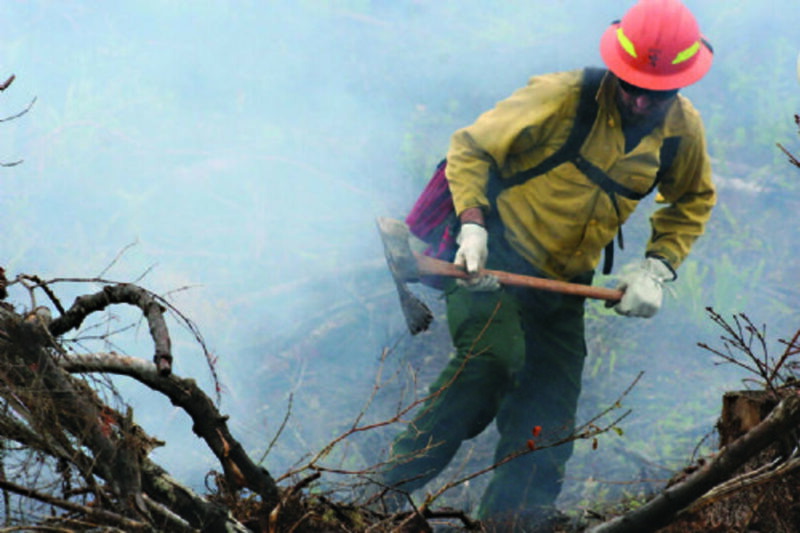Sean C. Morgan
Friday morning was wet enough to keep fine fuels full of moisture, but live training fires were still able to give young firefighters a chance to deal with conditions they’ll encounter this year fighting wildland fires.
About 120 trainees from several firefighting agencies spent the week in the 18th annual Wildland Firefighting School in Sweet Home last week. After four days of classroom and field exercises, the trainees encountered live training fires among slash piles set up by Cascade Timber Consulting on land it manages in the Ames Creek area on Friday.
The Oregon Department of Forestry entered fire season on July 1, and with it, the Quartzville Corridor is under regulated use, said Chad Calderwood, Sweet Home Unit forest protection supervisor.
In addition to new trainees, experienced firefighters received advanced training. Among them were Erick Larkin, a national resources technician with the U.S. Forest Service Sweet Home Ranger District who moved to Sweet Home from Bend last year, and Levi Marchbanks, a firefighter with the ODF Sweet Home Unit.
The Sweet Home Unit also sent its new mechanic, Justin Chafin, and four new firefighters, Dustin Winnington, Tomas Rosa, Kyle Hummer and Chris Barnes.
Larkin spend the week taking classes for leadership, he said. “Sweet Home, we don’t have an active fire unit. It’s kind of like a militia.”
That means Forest Service employees must be prepared to fight fires. Larkin took his initial training in fighting fires in Redmond in 2011.
Participating agencies were the ODF; four national forests, including Willamette, Siuslaw, Umpqua and Rogue River-Siskiyou; and the Bureau of Land Management.
“Fire School provides essential training in wildland fire for new firefighters and offers seasoned firefighters a chance to expand their skills and explore leadership opportunities,” said Co-Incident Commander Craig Pettinger, Sweet Home Unit forester, Oregon Department of Forestry. “Private forest landowner Cascade Timber Consulting, Inc., is providing us with a field site for real-life exercises. This greatly enhances the students’ training experience with smoke-filled air, hiking through uneven terrain and working together as crew members to dig fireline.”
Trainees spend the first part of the week in an intensive classroom setting that included several field sessions. Courses included beginning and intermediate fire behavior; communications; teamwork; leadership development; fireline safety; use of engines, tools and hose lays; and fire investigation.
Students spent the week sleeping in tents on the Sweet Home High School athletic practice fields and eating meals together, simulating a real fire camp. The week culminated in the live fire exercise, in which trainees were able to apply and develop their new skills and knowledge by suppressing and mopping up fires.
“This training and setting strengthens communications and builds effective interagency relationships for a more coordinated response during fire season,” said Paul Hiebert, fire management officer for the Detroit and Sweet Home ranger districts of the Willamette National Forest. He views fire school as “an engaging and collaborative way to train firefighters in tactical skills and safety.”
“It went really well,” Calderwood said. “They got to learn the basic foundation for how we fight fire in the Sweet Home Unit with a basis in interagency cooperation with the Forest Service.”
At lower elevations, precipitation is expected to be lower than normal and temperatures higher than normal, while at higher elevations on the National Forest, predictions are for a normal fire season.
“Seasoned firefighters always say, ‘Ask me in October,’” said Willamette National Forest Spokeswoman Judith McHugh. Based on weather and historical data, fires may be more likely in California and southern Oregon. Around the Willamette National Forest, fire season should be normal.
One important correlation is how late in the year rain keeps falling, McHugh said. The later it falls, the less likelihood of fire.
The presence of lightning affects the likelihood of fires too, she said, and human-caused fires are always a concern.
The Forest Service allows campfires as long as possible, McHugh said. If people are responsible and put out their campfires, the Forest Service will allow campfires, but when officials see a pattern of escaped campfires, they’ll take a look at prohibiting them.
On ODF-protected lands, which includes private forestland and Bureau of Land Management lands around Sweet Home, officials are forecasting higher-than-normal fire danger.
Calderwood said that the fires on Friday burned well and that despite rain, the heavier fuels had not recovered and had remained dry. The Sweet Home Unit has deployed to two fires already, one in the Klamath Falls area and one in the Bend area.
The Sweet Home Unit fire crew is trained and ready as fire season gets under way, Calderwood said.





